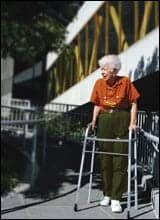Kessler Foundation researchers report that a link may exist between the built environment and disability-related outcomes for adults with physical impairments. Study authors included Amanda Botticello, PhD, MPH, and Nicole Cobbold, BS, Kessler Foundation, along with Tanya Rohrbach, MS, of Raritan Valley Community Collegem Branchburg, NJ.
Botticello explains that previous studies indicate characteristics such as poor street conditions, homogenous land use, traffic, and ambient hazards are largely predictive of more reported health issues, functional limitations, inactivity, and social isolation among older adults.
During the study, according a news release from the Kessler Foundation, researchers explored the link between community and neighborhood land uses and community participation using cross-sectional data from 508 community-living adults with acquired chronic disabilities in New Jersey.
These data reportedly yielded from the national Spinal Cord Injury Model database. The release notes that participants’ residential addresses were geocoded, enabling individual survey data to be linked with Geographic Information Systems data on land use and destinations.
“…The objective was to look at the impact of the built environment (or the physical features of geographic areas) on the members of the disabled population who are not generally visible in population-based studies, such as persons with chronic spinal cord injury. This line of research may help delineate factors that affect how well a person with an acquired physical disability adjusts to living in the community,” Botticello says.
The study’s results suggest that living in communities with greater land use mix and more destinations were linked to a decreased likelihood of reporting optimal social and physical participations. Living in neighborhoods with large portions of open space, however, the release says, was positively linked to the reporting of full physical, occupational, and social participation.
Botticello notes in the release that “Overall our analysis suggested that the living conditions or natural aspects of the local community may be relevant to well-being for persons with physical disabilities living in densely populated regions like New Jersey.”
Botticello adds the findings spotlight the environment as a key factor to be considered in disability-related outcomes, stating “They are relevant to those who seek to improve the outlook for community participation, including outcomes researchers, policymakers, and professionals who care for people with disabilities.”
Source(s): Science Daily, Kessler Foundation





